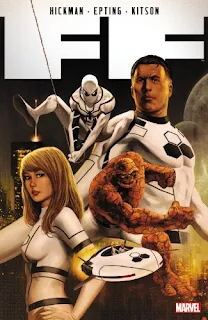[Review by Doug Glassman, who Tumblrs at '80s Marvel Rocks!]
Given my perception of the story upon first reading it three years ago, the switchover from Fantastic Four to FF Vol. 1 was smoother than I had expected. Many of the big changes that could have been dropped on the readers in the first issue of FF were instead introduced or teased in the "final" issue of Fantastic Four. Spider-Man's addition to the team was heavily advertised months in advance. The real surprise of the first issue is the return of enemies that had gone largely unseen since Jonathan Hickman's first Fantastic Four arc: the Council of Reeds ... or at least, what remains of them.
Of the many ideas that find repetition in Hickman's Marvel work -- incursions, faltering systems, alternate universe equivalents -- one of the biggest is "Evil Reed Richards." This rarely applies to the Reed of Earth-616, as demonstrated by his temptation towards evil and eventual rejection of the Council. The Reeds take advantage of the chaos in the world in general and the Future Foundation in specific and spread out among previously-seen hotspots. One teams up with the Mole Man to reverse the evolving Moloids. Another plays the factions of Atlantis against each other. A third makes a power play to ally with Annihilus. The fourth city of the War of the Four Cities, Attilan, is the only one that can see through their treachery.
I mentioned in the previous trade that there were certain "silent" sequences that are reprised in issues of FF with added dialogue. One of these finds Valeria Richards overhearing the plans of the Reeds, and so she takes point in finding a way to stop them. As the de facto leader of the children of the Future Foundation, Valeria becomes an even bigger main character, and with the support of her grandfather Nathaniel, she develops an out-of-the-box plan. She calls for the Fantastic Four's smartest villains to come together for a symposium on defeating Reed Richards. The Wizard is joined by the Mad Thinker, the alchemist Diablo, and two of AIM's top scientists; one of these is Andrew Forson in his first appearance, who would go on to menace both the Avengers and the Secret Avengers as Scientist Supreme.
Of course, you can't have a meeting about Reed Richards and leave out Doctor Doom, with Kristoff Vernard restoring his mind and Valeria keeping him in check. Though Doom showed signs of his master planning before, this is where his Secret Wars depiction really takes hold. The adults of the Future Foundation are not thrilled with this turn of events; the Thing essentially moves out in order to not clobber the new villainous advisors, and the Invisible Woman only concedes to this set-up for a limited time. It turns out that the villains are not the best people to turn to, as their insanity and backstabbing tendencies nearly kill the whole Foundation in FF Vol. 2. I do find it a little strange that Kang or one of his alternate selves wasn't invited; on the other hand, getting Kang involved would have made things even more confusing.
Recruiting Spider-Man as Johnny Storm's replacement was inevitable, while it sounds controversial, FF might provide the strongest reason against Spidey being a permanent member of the Fantastic Four. Without Johnny to bounce off of, his wittiness declines in the company of his three older teammates. It doesn't help that the gruesome death of the man he's replacing is fresh in the minds of the Future Foundation. The book isn't overall too somber but his loss is palpable. His presence also shifts the team's power dynamic too much, robbing the classic line-up of its best offensive player.
The best replacement might have instead been Crystal of the Inhumans, who does appear in the second trade as the Inhumans make their grand return to Earth. This comes at the expense of abandoning the Kree Empire that they had been ruling. An opportunity opens up for the return of the Kree Supreme Intelligence, which is done so in one of the most uniquely grotesque methods possible. This is another event with a greater significance in hindsight, starting the Inhumans on the path that would lead to their much greater exposure today.
One of my favorite moments in FF comes in issue #11, the last issue in the second trade. Realizing his and Valeria's mistakes, Reed summons the Avengers and X-Men to the Baxter Building to explain the problem of the upcoming War of the Four Cities. I found this scene very interesting for two reasons: firstly, the huge assembly of Avengers brings to mind the "Avengers World" line-up, and many of those members are present here. Secondly, this happens during the transition from the Bendis Avengers years to the Hickman Avengers years, marked by the introduction of the snub-nosed Quinjet.
FF Vol. 1 and Vol. 2 shouldn't be read without the context of the Fantastic Four run that they follow. While the first trade was decent on its own, it took on a far greater quality when I read it knowing the full backstory. I'll be returning to the saga of the Future Foundation soon enough, but next week, it's time to take to the high seas in my "Entry Plug" feature ... and no, it's not One Piece.

High Seas? Aquaman?
ReplyDeleteActually, it's a manga that a certain creature might claim to come from.
DeleteHm, my next guess would be Vinland Saga, but the word creature is tripping me up. There's no creature in Vinland Saga......and I can't think of a manga that has a well known creature, unless your talking about Godzilla, but would he even have a manga? I actually don't know about that....Hm.....this is a toughy.
ReplyDelete